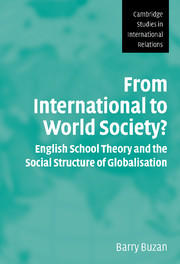 From International to World Society?
From International to World Society? Book contents
- Frontmatter
- Contents
- List of figures and tables
- Preface
- List of abbreviations
- Glossary
- Introduction
- 1 English school theory and its problems: an overview
- 2 World society in English school theory
- 3 Concepts of world society outside English school thinking
- 4 Reimagining the English school's triad
- 5 Reconstructing the pluralist–solidarist debate
- 6 The primary institutions of international society
- 7 Bringing geography back in
- 8 Conclusions: a portrait of contemporary interstate society
- List of references
- Index
- CAMBRIDGE STUDIES IN INTERNATIONAL RELATIONS
2 - World society in English school theory
Published online by Cambridge University Press: 14 January 2010
- Frontmatter
- Contents
- List of figures and tables
- Preface
- List of abbreviations
- Glossary
- Introduction
- 1 English school theory and its problems: an overview
- 2 World society in English school theory
- 3 Concepts of world society outside English school thinking
- 4 Reimagining the English school's triad
- 5 Reconstructing the pluralist–solidarist debate
- 6 The primary institutions of international society
- 7 Bringing geography back in
- 8 Conclusions: a portrait of contemporary interstate society
- List of references
- Index
- CAMBRIDGE STUDIES IN INTERNATIONAL RELATIONS
Summary
As Little (2000: 411) notes, world society is ‘the most problematic feature’ of the English school framework. Yet that world society is crucial to English school theory cannot be in doubt. If English school theory is to work as a vehicle for a methodologically pluralist approach to IR, then each of its three pillars must have the same clarity and the same standing as the others. Yet what world society means in relation to solidarism is far from clear, with a consequent blurring of the boundary between international and world society. In figure 1, the conjunction of international system and realism/Hobbes is wholly conventional, and that of international society and rationalism/Grotius poses no obvious difficulties (notwithstanding that there are substantial debates going on about how to interpret Hobbes, Machiavelli and Grotius). But the conjunction of world society, revolutionism and Kant rings several alarm bells. Revolutionism seems particularly out of line with most of what is currently discussed under the heading of world society, and it is not clear that Kant fits comfortably with either image. Transnationalism, cosmopolitanism and crusading universalist ideologies are implausibly crammed together in the world society segment. To make matters worse, the world society segment lacks a ‘world system’ counterpart: international system and international society compose a clear set, differentiating physical systems of interaction from socially constructed ones. World society is clearly aimed at socially constructed non-state systems, but what is its physical counterpart?
- Type
- Chapter
- Information
- From International to World Society?English School Theory and the Social Structure of Globalisation, pp. 27 - 62Publisher: Cambridge University PressPrint publication year: 2004
- 2
- Cited by


